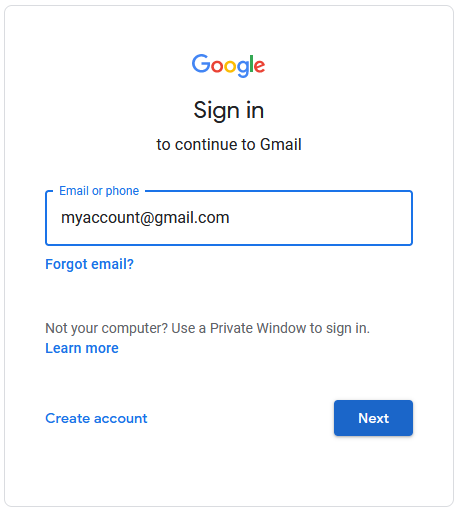Gmail Login: Gmail, Google’s ubiquitous email service, boasts over 1.5 billion users globally, emphasizing its importance in daily communications.
Understanding secure login methods is crucial to protect your personal information from unauthorized access, ensuring your digital correspondence remains private and safe.
Preparing to Login to Your Gmail Account
Before you access your Gmail account, ensuring a smooth login process is crucial. Here’s how to prepare effectively:
Ensure You Have the Necessary Equipment
To log in to your Gmail account, you need a few basic pieces of equipment:
- A Reliable Internet Connection: Stable internet is essential to access your emails without interruption.
- A Compatible Device: Whether you use a computer, tablet, or smartphone, ensure it can run a web browser or the Gmail app effectively.
- Web Browser or Gmail App: Make sure you have the latest version of a web browser (like Chrome, Firefox, or Safari) or the Gmail app installed on your device.
Importance of Having Your Login Credentials Ready
Keeping your login credentials at hand is vital for a few reasons:
- Quick Access: Having your username and password ready helps you log in faster, saving you time and reducing frustration.
- Security: Knowing your credentials by heart or storing them securely (e.g., in a password manager) minimizes the risk of unauthorized access and ensures you are the only one accessing your account.
- Efficiency: If you manage multiple accounts, having organized and accessible login details allows for efficient switching between them without delays.
By preparing your equipment and credentials before logging in, you can enjoy a seamless and secure access to your Gmail, keeping you connected and productive.
Step-by-Step Guide to Gmail Login @ gmail.com
Navigating Gmail login procedures is straightforward. Whether you’re accessing your email via the web or through the app, follow this simple guide to get started. Here’s how to do it:
For Web Users
1. Open Your Browser: Launch your preferred web browser and go to gmail.com.

2. Enter Your Credentials: If you are not automatically logged in, you will see the login page. Enter your Gmail address (or phone number) and click ‘Next’. Then, enter your password and click ‘Next’ again.
3. Access Your Inbox: Once logged in, you’ll be directed to your inbox where you can view and manage your emails.
For App Users
1. Download the Gmail App: If you haven’t already, download the Gmail app from your device’s app store (Google Play Store for Android or App Store for iOS).
2. Open the App: Tap on the app icon to open it. If you’re not signed in, you’ll be prompted to add your Google Account.
3. Sign In: Enter your Gmail address and tap ‘Next’. Then, enter your password and tap ‘Next’ again.
4. Explore Your Mail: After signing in, the app will take you directly to your inbox.
Importance of Reviewing Terms Before Agreeing
Before clicking ‘Agree’ on any service, including Gmail, it’s vital to review the terms and conditions. Here’s why:
1. Understanding Your Rights and Responsibilities: The terms outline what you can and cannot do, as well as what the service provider owes you.
2. Privacy Concerns: Terms often contain information on how your data is used and protected. Knowing this is crucial for your digital safety.
3. Changes in Service: Services often update their terms based on new laws or business needs. Understanding these can help you decide if you wish to continue using the service under the new rules.
Taking the time to understand these elements ensures you are making informed decisions about the services you use online.
Understanding Gmail’s Security Features
Gmail offers robust security features to safeguard your emails and personal data from unauthorized access and cyber threats. Two key features that enhance account security are Two-Factor Authentication (2FA) and security alerts, including login notifications. Here’s an easy-to-follow guide on these crucial security measures.
Importance of Two-Factor Authentication (2FA)
Enhanced Security: Two-factor authentication adds an extra layer of security by requiring two forms of identification before you can access your account. This means even if someone has your password, they can’t access your account without the second form of verification.
Reduced Risk of Hacking: With 2FA, the chances of an unauthorized person accessing your account are significantly lower. This security measure is particularly important in an era where personal data can be particularly vulnerable to cyber attacks.
How to Enable Two-Factor Authentication
- Log in to Gmail: Open your Gmail account and go to the Google Account settings.
- Navigate to Security Settings: Find the “Security” tab on the left-hand panel and click on it.
- 2FA Section: Scroll to the “Signing in to Google” section and click on “2-Step Verification.”
- Get Started: Click on “Get started” and follow the prompts to set up your two-factor authentication, choosing your second verification method, such as a text message or Google Authenticator app.
- Verification: Complete the process by verifying your chosen method.
List of Security Alerts and Login Notifications
Security Alerts: Gmail automatically sends security alerts to your recovery email if it detects unusual activity, such as an attempted sign-in from a new device or location. These alerts help you take immediate action to secure your account if necessary.
Login Notifications: You can also set up login notifications to receive alerts every time your Gmail account is accessed from a new device. This can be enabled through your account settings under “Device activity and security events.”
By understanding and utilizing these Gmail security features, you can significantly enhance the safety of your personal information and maintain better control over your digital communications.
Best Practices for Managing Your Gmail Account
Managing your Gmail account effectively ensures that your communications are secure and your data remains private. Here are some key practices to maintain optimal security and functionality:
Regular Password Updates
Updating your password regularly is crucial for protecting your account from unauthorized access. It’s recommended to change your password every few months or immediately if you suspect it’s been compromised. Benefits of using a password manager include:
- Enhanced Security: Password managers generate strong, unique passwords for each of your accounts, reducing the risk of security breaches.
- Convenience: They store all your passwords in one secure location, accessible with a single master password.
- Efficiency: Save time with auto-fill options for passwords and forms.
Checking Account Activity
Regularly checking your account activity can help you monitor for any unauthorized access or suspicious behavior. Google provides an “Activity” feature that shows the devices and locations where your account has been accessed. Importance of monitoring activity:
- Immediate Detection: Spotting unusual activity early helps you take swift action to secure your account.
- Maintain Control: Regular checks ensure you remain informed about who is accessing your account and from where.
Keeping Your Recovery Information Up-to-Date
Ensure your recovery email address and phone number are always current. This information is vital for regaining access to your account if you forget your password or if it gets locked. Benefits include:
- Quick Recovery: Updated information speeds up the account recovery process, minimizing disruption to your access.
- Prevent Lockouts: Helps in preventing permanent lockouts caused by forgotten passwords or unauthorized changes.
However, implementing these best practices will significantly enhance the security and efficiency of your Gmail account, keeping your communications smooth and secure.
Advanced Login Options and Tips
In today’s digital world, ensuring secure and efficient access to your email is paramount. Whether you’re using Gmail with third-party clients, logging in from various devices, or dealing with suspected unauthorized access, here are advanced options and tips to help you maintain control and security of your account.
Using Gmail with Third-Party Email Clients
- Choose Supported Email Clients: Opt for clients like Microsoft Outlook, Apple Mail, or Mozilla Thunderbird, which support IMAP and offer full compatibility with Gmail.
- Enable IMAP in Gmail Settings: Go to your Gmail settings, find the ‘Forwarding and POP/IMAP’ tab, and ensure IMAP is enabled. This allows your third-party client to retrieve your Gmail messages.
- Use App-Specific Passwords: If you have two-factor authentication enabled, generate an app-specific password for your email client instead of using your Gmail password. This enhances security.
Logging in from Different Devices Safely
- Use Two-Factor Authentication (2FA): Always enable 2FA to add an extra layer of security when logging in from new or different devices.
- Verify Security Certificates: When accessing Gmail from a web browser, ensure the site’s security certificate is valid by checking for a padlock icon in the address bar.
- Log Out After Use: Especially on shared or public devices, always log out of your account to prevent others from accessing it.
What to Do if You Suspect Unauthorized Access to Your Account
- Change Your Password Immediately: If you suspect unauthorized access, change your Gmail password without delay to lock out potential intruders.
- Review Account Activity: Check your Gmail account activity to see if there are any unfamiliar locations or devices that have accessed your account.
- Update Recovery Options: Ensure your recovery email and phone number are up to date to recover your account and reset your password if necessary.
- Report to Google: Use Google’s security tools to report and investigate any unauthorized access, helping prevent future breaches.
By following these advanced login options and tips, you can ensure that your Gmail account remains secure and accessible, no matter where you are or what device you use.
FAQs about Gmail Login
How do I log into my Gmail account?
To log into your Gmail account, visit the Gmail website at mail.google.com. Click on the “Sign in” button, then enter your Gmail email address and password. If you have multiple Google accounts, make sure to select the correct one. Click “Next” to access your inbox.
What should I do if I forget my Gmail password?
If you forget your Gmail password, click on the “Forgot password?” link on the login page. Follow the prompts to reset your password. You may need to verify your identity using a recovery email address or phone number associated with your account.
Can I log into Gmail without a Google account?
No, you need a Google account to access Gmail. If you don’t have one, you can create a Google account on the Gmail website by selecting “Create account” and following the instructions.
How do I securely log into Gmail on public computers?
When using public computers, always log out of your Gmail account after you finish. Avoid saving your password on public devices. Additionally, consider using Google’s 2-Step Verification for an added layer of security.
What are the common problems with Gmail login?
Common issues include forgetting your password, trouble with 2-Step Verification, or encountering a security alert blocking your login. Ensure your browser is up-to-date and clear your cache and cookies if problems persist.
Conclusion
In conclusion, adopting secure Gmail login practices is not just a recommendation—it is a necessity in today’s digital landscape. By ensuring that your login details are protected, you safeguard your personal information from cyber threats and unauthorized access.
Regularly updating your security information, such as passwords and recovery options, significantly enhances your defense against potential breaches. We encourage you to stay vigilant and proactive in managing your email security.
Remember, a few mindful steps can make a substantial difference in protecting your digital life. Make it a habit to review and refresh your security settings to ensure you are always one step ahead in maintaining your online safety.
References
For additional insights and to verify the information provided on Gmail login procedures, consider exploring the following reputable sources. These links offer in-depth knowledge and guidance to ensure a secure and efficient email management experience:
- Google Support: For comprehensive tutorials and troubleshooting guides directly from Gmail’s parent company, visit Google’s official support page.
- Digital Trends: For user-friendly articles and updates on Gmail features, check out Digital Trends.
- TechRadar: To stay informed about the latest technology trends, including email management tips and software updates, visit TechRadar’s website.
Each source has been selected for its reliability and authority, providing readers with trusted information to enhance their Gmail usage and security.

